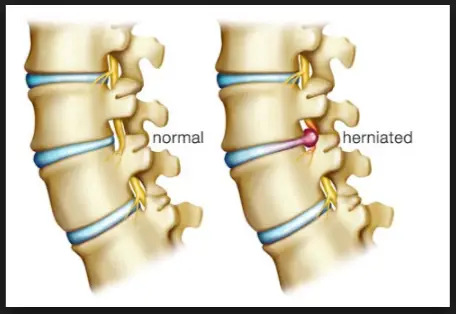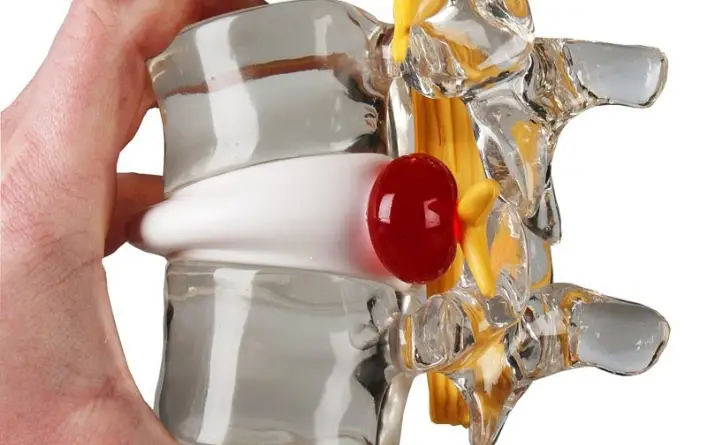What Is a Herniated Disc – A Quick Overview
Before diving into the important details about your herniated disc, it is important to understand what’s actually happening in your body.
The spine is made up of 24 vertebrae, bones, each stacked on top of one another to create a canal that serves as protection for the spinal cord. The area containing five vertebrae in your lower back is referred to as the lumbar spine. The spinal cord and nerves travel down the canal created by your vertebrae and carry signals between your brain and muscles. Additionally, flat, round shock-absorbing discs called intervertebral discs are situated between each vertebra. These discs are made up of the annulus fibrosus, a tough outer covering that makes up the outer ring, along with the nucleus pulposus, the soft, jelly-like portion contained in the center of the intervertebral disc.
Contents
Herniated Disc Meaning
A disc is described as herniated when the nucleus pulposus (the jelly-like substance) pushes against the annulus fibrosus (the outer ring), which could be due to a sudden injury or could occur naturally as your body ages. This pressure from the nucleus pulposus is responsible for the lower back pain associated with a herniated disc.
Scientists do not fully understand why the disks are herniated. Most theories attribute this condition to a combination of the following factors:
- The aging of the disk – Hereditary discs is rare in young people, but common among people aged 35 to 55. Of all the factors responsible for the hernia disks, aging is probably the most important. With age, the outer shell of the disc seems to degenerate slowly, probably due to decades of straight posture and back bending.
- Genetic factors – In some families, more close relatives suffer from herniated disks, while other families are not affected at all. If the condition takes place in a family, it may have an unusually early start, even affecting people younger than 21. Studies are beginning to identify specific genes related to hereditary forms of disc disease.
- Individual risk factors – You may be at increased risk of a herniated disc if you are working in a job or participating in a sport that involves heavy lifting or excessive twisting or bending.
Symptoms associated with a herniated disc include:
- Pain and numbness, most commonly on one side of the body
- And the pain that extends to your arms and/or legs
- Also, pain that worsens at night
- Pain that worsens after standing or sitting
- And pain when walking short distances
- Unexplained muscle weakness
- Tingling, aching or burning sensations in the affected area
Herniated Disc Treatment

It is important to see a chiropractor immediately if you begin to experience the symptoms of a herniated disc. So that you can be properly tested by physical examination or image testing. Failing to see a chiropractor for treatment may result in a worsening of your injury. And, therefore, a longer, possibly more painful recovery.
Before physical therapy can begin you will need to deal with any issues of pain that you might be having as it can be very difficult to proceed with these treatments if you are in severe pain.
Many people who suffer from a herniated disc do so because of weak core muscles. Your spinal column must hold up the weight of your body. So if you’re lower back and abnormal muscles are weak and out of shape, they cannot perform this job to the best of its ability.
Herniated disc exercises, or core exercises, can be used to strengthen the oblique, abdominal, lower back and gluteus muscles. By working for these muscle groups you help to develop a strong and limber core.
A core exercise routine should ideally be tailored to your specific problem and lifestyle. It is also something that you can keep doing once you no longer have back pain, as it will help to keep your core strong reducing the chance of re-injury.
Stretching also goes well with core exercises and can be very beneficial for those cramped or chronically shortened muscles.
Another way of exercising is water therapy. This combines aerobic exercise and water and is a type of resistance training. Exercising in the water is very low impact and helps to reduce the amount of stress on your joints. Because this is a near zero-gravity environment, it is very helpful for those who are elderly, injured or recovering from a surgery.
Back braces or corsets can be worn to keep the spine immobile in those with weak back muscles. This form of treatment should always be combined with an exercise program as you do not want your back to start relying on the brace to keep your spine properly aligned.
Depending on the severity of your injury, multiple treatment approaches may be taken, for example, physical therapy, muscle relaxant medications, pain medications, anti-inflammatory medications, local injection of cortisone and surgical operations.
Prevention
To help prevent a herniated disc in the future you should always take preventative measures such as:
Exercise
Studies have shown that exercise can help to slow down the age-related degeneration of the spine and its structures. Consult with your doctor before starting any exercise routine if you have had any previous back injury. As they may want you to avoid certain high impact exercises or certain types of aerobics.
Maintain a healthy weight
For every extra pound of weight you carry, you add 3 pounds of pressure to the spinal column; this extra pressure can not only lead to herniated discs. It can speed up the process of the degenerative spine cascade.
Learn and use proper postures
This does not only mean keeping your back straight when you sit. It is just as unhealthy for you if you lift heavy or awkward objects improperly. Always use your legs and not your back when lifting up something.
Quit smoking
Smoking is not only unhealthy for your lungs it is unhealthy for your back. Smokers are at a higher risk of developing back problems due to the toxins in cigarettes.
When to call a doctor?
Call your doctor immediately if you develop severe back pain, especially if you suffer from pain or numbness in your arms or legs or if you lose control of your bowel or bladder.



Pingback: How To Get Rid Of Sharp Pain In The Middle of Back - Body Pain Tips
Pingback: What Does A Slipped Disk Feel Like? - Body Pain Tips
Pingback: 12 Worst Causes of Hip Bone Pain - Body Pain Tips